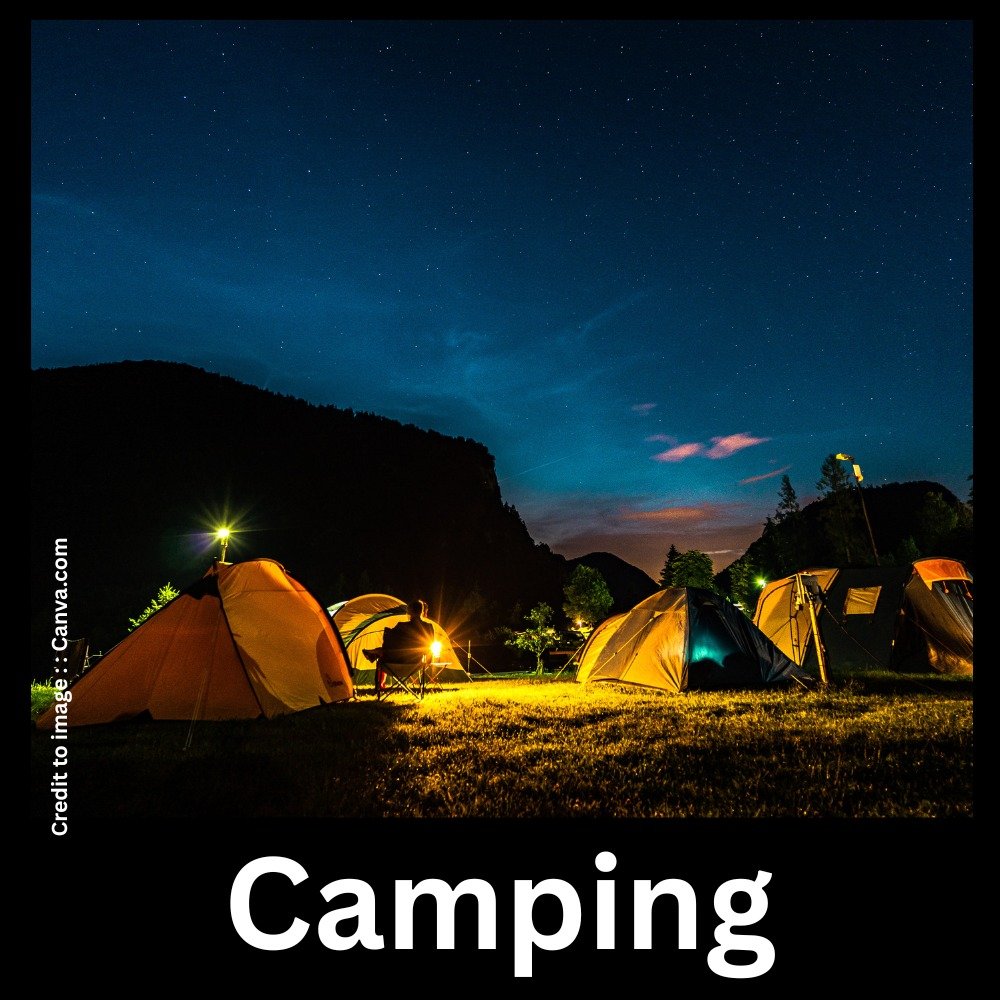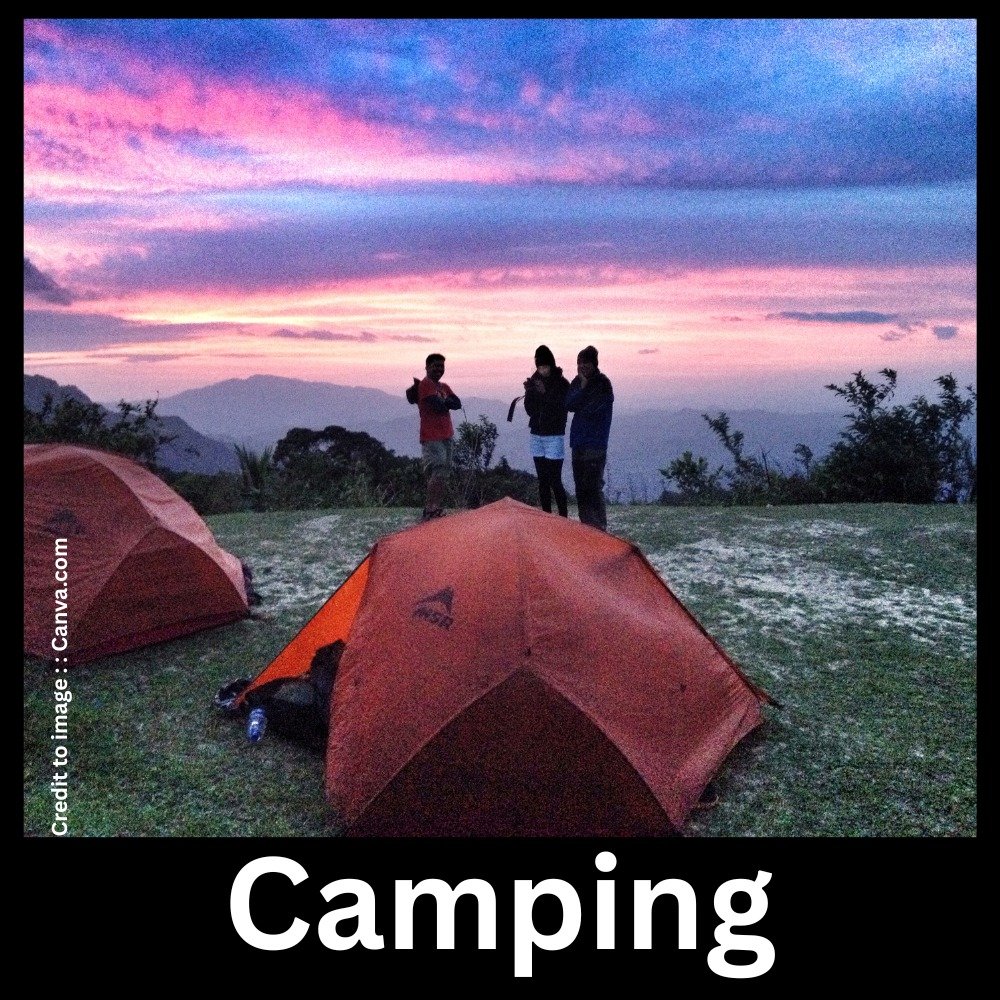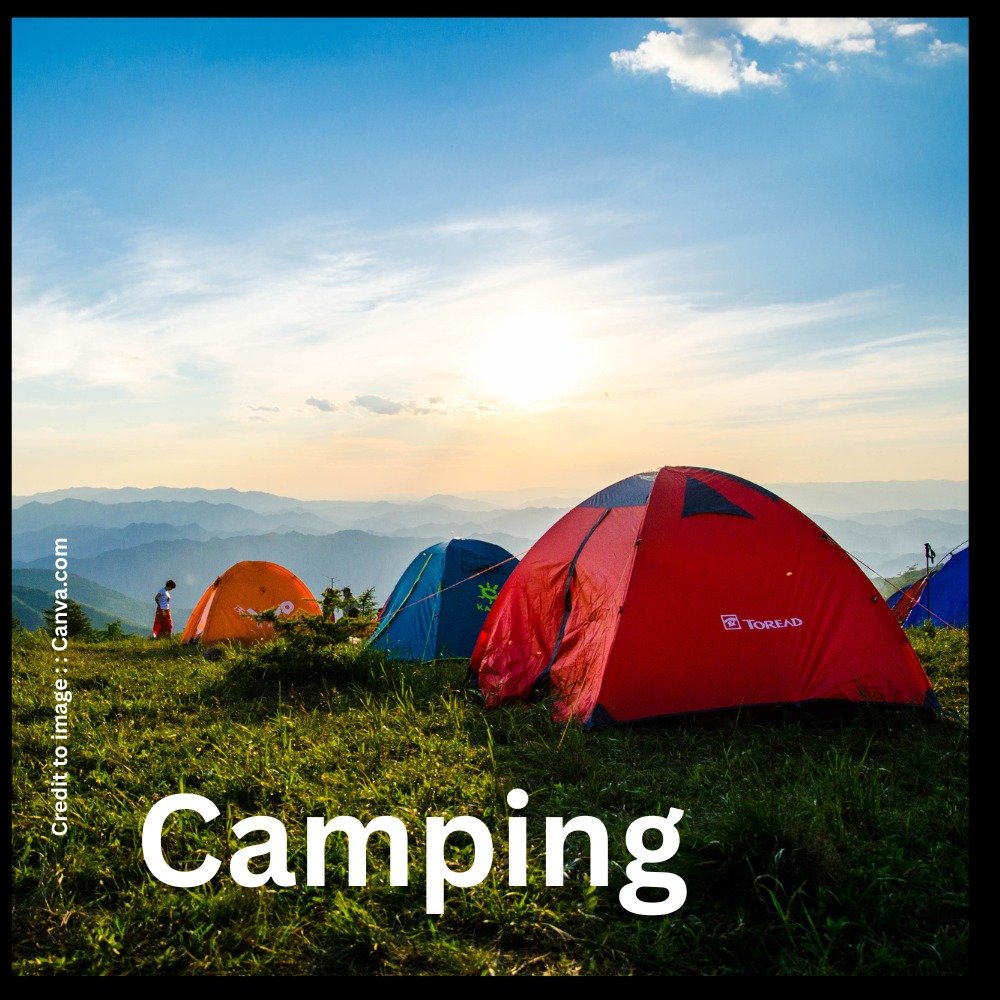Camping is one of the most popular outdoor activities that allows people to reconnect with nature, escape the stress of daily life, and experience adventure in the wild. This comprehensive guide explores the history , different types of camping such as tent , car , backpacking, RV , glamping, and survival camping’s, and provides practical tips for beginners and experienced campers alike. Choosing the right campsite, packing essential camping gear, preparing delicious food, and following safety guidelines are crucial for a successful trip.


The article also emphasizes family-friendly camping with kids and pets, while highlighting the importance of Leave No Trace principles to protect the environment. From the best camping destinations in the USA, Europe, and around the world to the physical and mental health benefits of outdoor living, readers will find valuable insights to make their camping experience enjoyable and safe.
By incorporating safety advice, expert recommendations, and sustainable practices, international camping destinations etc , this article offers everything you need to know about camping.
Table of Content
- Introduction
- The History of Camping
- Why People Love Camping
- Types of Camping
- Choosing the Perfect Campsite
- Essential Camping Gear
- Camping Food Ideas
- Safety Tips for Campers
- Camping with Kids
- Camping with Pets
- Leave No Trace Principles
- Best Camping Destinations Worldwide
- Benefits of Camping for Health
- Challenges of Camping
- Conclusion: Why Camping is a Life-Changing Adventure
- FAQs
- References
Introduction
Camping isn’t just about sleeping under the stars—it’s about escaping the noise of daily life and finding peace in the arms of nature. Whether you’re a seasoned outdoor explorer or just curious about your first night in a tent, It offers a refreshing break from screens, traffic, and routine.
The History of Camping
Camping has evolved drastically over time.
- Early Survival Camping: Thousands of years ago, humans camped out of necessity for food and shelter while hunting or migrating.
- Modern Recreational Camping: In the late 19th and early 20th centuries, camping became a recreational hobby. National parks encouraged city dwellers to reconnect with the natural world.
Why People Love Camping
So, why is camping so popular?
- Connection with Nature: Nothing beats the feeling of waking up to birdsong or the crackle of a campfire.
- Stress Relief: Outdoor air, quiet trails, and starry nights are nature’s therapy.
- Affordable Adventure: Compared to expensive hotels, it is budget-friendly.
Types of Camping
It comes in many flavors:
- Tent Camping – The classic setup: just you, your tent, and the wilderness.
- Car Camping – Park close and pitch a tent with easy access to supplies.
- Backpacking – Hiking with all gear on your back for ultimate adventure.
- RV Camping – Comfort meets nature with mobile homes.
- Glamping – Luxury meets camping with cabins, yurts, or pre-set tents.
- Survival Camping – Minimal gear, maximum wilderness skills.
Choosing the Perfect Campsite
The right campsite sets the mood for your adventure.
- National Parks & Forests – Scenic views and facilities.
- Private Campgrounds – Convenient with amenities.
- Remote Wilderness – For those who want solitude and challenge.
Essential Camping’s Gear
You don’t need a truckload of gadgets, just the basics:
- Shelter & Sleeping Gear – Tent, sleeping bag, and pad.
- Cooking Equipment – Stove, cookware, utensils.
- Clothing & Footwear – Weather-ready layers and hiking boots.
- Navigation Tools – Map, compass, or GPS.
Camping’s Food Ideas
Food is half the fun outdoors.
- Easy Meals – Hotdogs, pasta, foil-packet meals.
- No-Cook Options – Sandwiches, fruits, energy bars.
- Food Safety – Store perishables in coolers, hang food away from wildlife.
Safety Tips for Campers
Staying safe ensures the fun lasts.
- Wildlife Awareness – Observe animals from a distance.
- Fire Safety – Keep fires small, always extinguish completely.
- First Aid Kit – Pack essentials for scrapes, bites, or burns.
- Weather Prep – Check forecasts, carry rain gear.
Camping’s Do’s and Don’ts Table
| Do’s (✔️ Things You Should Do) | Don’ts (❌ Things to Avoid) |
| ✔️ Plan your trip in advance and research the campsite | ❌ Don’t leave food or trash unattended (attracts wildlife) |
| ✔️ Carry enough water, food, and first-aid supplies | ❌ Don’t disturb wildlife or their natural habitat |
| ✔️ Follow the “Leave No Trace” principle | ❌ Don’t play loud music that disrupts nature and campers |
| ✔️ Use eco-friendly gear and reusable utensils | ❌ Don’t cut down trees or damage vegetation |
| ✔️ Check weather forecasts before leaving | ❌ Don’t camp in restricted or unsafe areas |
| ✔️ Keep controlled and small campfires. | ❌ Don’t leave unattended campfires at camping place |
| ✔️ Store food properly in bear-proof containers | ❌ Don’t feed wild animals |
| ✔️ Respect fellow campers’ privacy and space | ❌ Don’t litter hiking trails or water sources |
| ✔️ Carry maps, GPS, or compass for navigation | ❌ Don’t rely solely on phone signals in remote areas |
| ✔️ Follow campsite rules and local regulations | ❌ Don’t overpack with unnecessary items |
Camping’s Safety Checklist – Must-Have Gear & Essentials
| Category | Essential Items |
| Shelter & Sleeping | Tent with rainfly, Ground tarp, Sleeping bag (season-appropriate), Sleeping pad |
| Navigation Tools | Map, Compass, GPS device, Headlamp/flashlight with extra batteries |
| Clothing & Footwear | Weather-appropriate layers, Waterproof jacket, Hiking boots, Extra socks & gloves |
| Food & Water | Portable stove, Cooking utensils, Reusable containers, Water bottles, Water filter/purification tablets |
| First Aid & Safety | First aid kit, Emergency whistle, Multi-tool/knife, Fire starter (matches/lighter), Sunscreen & insect repellent |
| Personal Essentials | Toiletries, Biodegradable soap, Trash bags, Power bank/solar charger |
| Emergency Gear | Emergency blanket, Signal mirror, Rope/cord, Extra food supply |
Camping with Kids
Kids see camping as a grand adventure. Make it fun with:
- Treasure hunts, stargazing, and marshmallow roasting.
- Bring comfort items like blankets or toys.
- Teach safety in a playful way.
Camping’s with Pets
Pets love nature too, but keep them safe:
- Carry enough food and water for them.
- Keep them leashed to protect wildlife.
- Bring a pet first-aid kit.
Leave No Trace Principles
Being responsible keeps nature beautiful:
- Take all trash back with you.
- Respect animals and other campers.
- Avoid damaging plants and trees.
Best Camping’s Destinations Worldwide
Some dream destinations include:
- USA – Yosemite, Yellowstone, Grand Canyon.
- Europe – Swiss Alps, Norway fjords, Scotland highlands.
- Worldwide – Patagonia (Chile), Banff (Canada), Outback (Australia)
Camping’s Destinations Data Table
| Destination | Country/Region | Best Season to Visit | Unique Features | Difficulty Level | Permit Required |
| Yosemite National Park | USA (California) | Spring–Fall (May–Oct) | Iconic granite cliffs, waterfalls, giant sequoias | Moderate | Yes (campsites & wilderness permits) |
| Yellowstone National Park | USA (Wyoming, Montana, Idaho) | Summer (Jun–Aug) | Geysers, hot springs, abundant wildlife | Easy–Moderate | Yes (campground reservations recommended) |
| Grand Canyon National Park | USA (Arizona) | Spring & Fall | Dramatic canyon views, hiking trails, river rafting | Moderate–Challenging | Yes (backcountry permits) |
| Swiss Alps | Switzerland | Summer (Jun–Sep) | Alpine meadows, snow-capped peaks, scenic trails | Moderate–Challenging | No (but some campgrounds need reservations) |
| Norwegian Fjords | Norway | Summer (Jun–Aug) | Majestic fjords, waterfalls, northern lights (winter camping) | Easy–Moderate | No |
| Scottish Highlands | Scotland (UK) | Late Spring–Early Fall | Wild landscapes, lochs, historic castles | Easy–Moderate | No (wild camping allowed with guidelines) |
| Patagonia | Chile & Argentina | Summer (Dec–Feb) | Glaciers, rugged mountains, remote wilderness | Challenging | Yes (for certain parks like Torres del Paine) |
| Banff National Park | Canada (Alberta) | Summer (Jun–Sep) | Rocky Mountains, turquoise lakes, wildlife | Easy–Moderate | Yes (campground reservations) |
| Australian Outback | Australia | Winter (May–Sep) | Desert landscapes, unique wildlife, starry skies | Moderate–Challenging | No (but camping in national parks may need passes) |
Benefits for Health
Camping is like medicine without a prescription:
- Physical Health – Hiking, swimming, chopping wood—great exercise.
- Mental Health – Fresh air and disconnecting from screens reduce stress.
Challenges of Camping
Yes, its hurdles are as follows :
- Forgetting essentials like matches.
- Weather surprises like rainstorms.
- Fear of bugs or wild animals.
But hey, these challenges are part of the adventure!
Conclusion: Why it is a Life-Changing Adventure
It teaches patience, resilience, and appreciation for nature. Whether you go once a year or every weekend, it’s an experience that reminds us of our roots—simple living, starlit skies, and the beauty of the great outdoors.
FAQs
1. What is camping?
It is an outdoor activity where people stay overnight in nature, typically in tents, RVs, or under the stars, to relax and explore.
2. What are the main types of camping?
Common types include tent , car , backpacking, RV , glamping, and survival camping.
3. What should I pack for a camping trip?
Key camping must-haves are a sturdy tent, a warm sleeping bag, basic cooking equipment, enough food and water, suitable clothing for the weather, and a reliable first-aid kit.
4. How do I choose a good campsite?
Look for level ground, access to water, shade, safety from wildlife, and check regulations for camping permits.
5. Is camping’s safe for beginners?
Yes. Start with car camping’s or established campgrounds before trying backcountry or wilderness camping’s.
6. What food is best for camping‘s ?
Easy-to-make meals like pasta, foil-packet dinners, sandwiches, fruits, and energy bars are great. Always carry no-cook options as backups.
7. How can I keep food safe from wildlife?
Use sealed containers, coolers, or hang food away from your tent. Follow campsite food storage rules.
8. How do I stay safe from wild animals while camping?
Maintain a tidy campsite, never feed wild animals, secure all food properly, and enjoy observing wildlife from a safe distance.
FAQs
9. Can I take my kids camping?
Absolutely! Camping is a fun family activity. Bring comfort items, plan games, and ensure safety rules are simple for kids to follow.
10. Can I take my pets camping?
Yes, many campsites allow pets. Keep them leashed, pack enough food/water, and carry a pet first-aid kit.
11. What is glamping?
Glamping (glamorous camping) is a luxury version of camping, offering comfort like cabins, yurts, or fully equipped tents.
12. How do I prepare for bad weather while camping?
Check forecasts, pack rain gear, waterproof your tent, and bring extra layers to stay warm.
13. Do I need a permit to camp?
Some national parks and wilderness areas require camp permits. Always check local rules before your trip.
14. What are the health benefits of camping?
It promotes physical activity, reduces stress, improves mood, boosts vitamin D exposure, and encourages mindfulness.
15. What are Leave No Trace principles?
They are outdoor ethics guidelines to minimize impact: pack out trash, respect wildlife, avoid damaging nature, and leave campsites as you found them.
References
- National Park Service – https://www.nps.gov/subjects/camping
- Leave No Trace Center for Outdoor Ethics: https://lnt.org/why/7-principles
- REI Expert Advice – https://www.rei.com/learn/c/camping
- American Hiking Society – https://americanhiking.org
- CDC – Outdoor Safety and First Aid: https://www.cdc.gov/disasters/outdoors
Disclaimers
- This article is intended for general informational purposes only and should not be taken as professional outdoor, medical, or survival advice.
- Always check local regulations, permits, and campsite rules before planning your trip.
- Outdoor activities, involve risks such as wildlife encounters, accidents, and weather changes. Readers should prepare accordingly and take full personal responsibility for their safety.
- The author and publisher of this article are not liable for any accidents, injuries, or losses incurred while camping.
- For health-related questions (e.g., First Aids with medical conditions), always consult a qualified medical professional before undertaking outdoor activities.
PRAKRITI DARSHAN-NATURE AND ENVIRONMENT MAGAZINE
Prakriti Darshan is a leading Hindi-language magazine and digital platform dedicated to raising public awareness on vital issues related to nature, biodiversity, climate change, sustainable development, and environmental conservation. This magazine represents a unique blend of science, society, and sensitivity—offering a common platform for researchers, students, NGOs, policymakers, nature lovers, and conscious citizens alike.
With thought-provoking articles, inspiring stories, environmental research, impactful projects, and policy perspectives, Prakriti Darshan is a transformative journey toward a greener and more sustainable future.
Let us come together to protect and preserve our planet for generations to come. 🌿🌍
Join us in our mission to protect and celebrate the planet. 🌏💚
Click for more information
- Visit www.prakritidarshan.com for Free Magazine ,Free membership benefits ,offered price magazine @ Rs.1 or Rs.11 only and more ……
- 🎗️Sponsor Prakriti Darshan Magazine – Support our environment mission.
- 📚 Explore the Environment Magazine – Read our latest and past issues.
- ✍️ Read Editor’s Article or Blog – Insightful thoughts from our editorial desk.
- 🌱 Join Membership – Be part of India’s leading green community.
- 🤝 Become an NGO Impact Story Partner – Share your grassroots impact nationwide.
- 🏢 Become a Company Partner – Showcase your CSR, ESG, or sustainability work.
- 👤 Become an Individual Partner – Volunteer, write, and raise your green voice.
- 📢 Advertise with Us – Reach eco-conscious readers across India.
- Eco Trails Newsletter
- Donate for “Hari Ho Vashundhara & Har school Hariyali “ Plantation campaign Associated Partner NGO :GDSS NGO www.gdssngo.org
BALA DATT SHARMA,
MANAGING EDITOR ,
PRAKRITI DARSHAN-NATURE AND ENVIRONMENT MAGAZINE
- Drake Passage: The World’s Roughest Sea Route Between Atlantic and Pacific Oceans - August 22, 2025
- Top 10 Natural Parks in the USA: Biodiversity, Geography & Global Relevance - August 21, 2025
- Exploring the Best Natural Parks in USA: Biodiversity, Sustainable Tourism, and Role in SDGs - August 21, 2025





